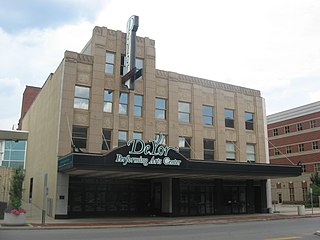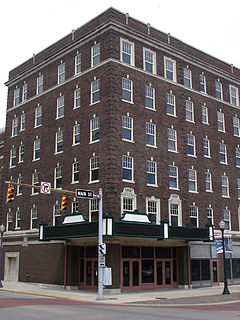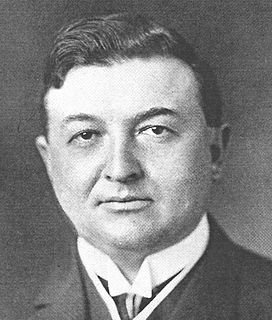
The Tennessee Theatre is a movie palace in downtown Knoxville, Tennessee. The theater was built in 1928 in the 1908 Burwell Building, considered Knoxville's first skyscraper. The theater and Burwell Building were added to the National Register of Historic Places in 1982, and the theater was extensively restored in the early 2000s. The Tennessee Theatre currently focuses on hosting performing arts events and classic films, and is home to the Knoxville Opera and the Knoxville Symphony Orchestra. The theater is managed by AC Entertainment.

Powers Auditorium, in Youngstown, Ohio is one of the largest auditoriums in the Youngstown-Warren area. The facility is the main venue of downtown Youngstown's DeYor Performing Arts Center. The complex also includes the Adler Art Academy, Beecher Flad Pavilion, and Ford Family Recital Hall. Originally built in 1931 as the Warner Theatre, the former movie palace was renovated and reopened as Powers Auditorium in 1969.

The Warner Grand Theatre is an historic movie palace that opened on January 20, 1931. It is located in San Pedro, Los Angeles, California, at 478 West 6th Street.

The Warner Theatre is an Art-Deco style movie palace located at 68-82 Main Street in Torrington, Connecticut. It opened on August 19, 1931 as part of the Warner Bros. chain of movie theaters. Today it operates as a mixed-use performing arts center. It is individually listed on the National Register of Historic Places and also a contributing property in the Downtown Torrington Historic District.

The Victory Theatre is a 1,950 seat venue in Evansville, Indiana. It is home to the Evansville Philharmonic Orchestra and also hosts local ballet and modern dance companies, theatre companies, and touring productions.

The Ohio Theatre is a theater on Euclid Avenue in downtown Cleveland, Ohio, part of Playhouse Square. The theater was built by Marcus Loew's Loew's Ohio Theatres company. It was designed by Thomas W. Lamb in the Italian Renaissance style, and was intended to present legitimate plays. The theater opened on February 14, 1921, with 1,338 seats. The foyer featured three murals depicting the story of Venus, and the balcony contained paintings of Arcadia. Throughout the 1920s, the Ohio had a stock company and hosted traveling Broadway plays.

John Adolph Emil Eberson was a European born American architect best known for the development and promotion of movie palace designs in the atmospheric theatre style.

The Pickwick Theatre is an art deco movie palace located in Park Ridge, Illinois, a suburb of Chicago.

Morris Performing Arts Center is a 2,564-seat concert hall located in South Bend, Indiana. It opened in 1922 as a vaudeville house and later became a movie palace. It was developed along with the neighboring Palais Royale Building by the Palace Theater Corporation. It is a four- to five-story, rectangular, Spanish Renaissance Revival style brick building with finely crafted terra cotta ornamentation. It was planned for demolition in 1959 but was saved from demolition, and between 1998 and 2000, it was restored and remodeled.

The Grand Theatre in Douglas, Arizona, designed by M. Eugene Durfee, opened in 1919. Ginger Rogers, Pavlova and John Philip Sousa to mention just a few performed on stage at the Grand Theatre. Originally, it also housed a Tea Room, a candy store and a barbershop. It was the site of many live stage productions, movies, and Douglas High School graduations.
The Boyd Theatre was a 1920s era movie palace in Center City, Philadelphia, Pennsylvania, United States. It operated as a movie theater for 74 years, operating under the name Sameric as part of the United Artists theater chain, before closing in 2002. The theater was the last of its kind in downtown Philadelphia, a remnant of an era of theaters and movie palaces that stretched along Market and Chestnut Streets. The Boyd's auditorium was demolished in the Spring of 2015 by its current owner Pearl Properties, which plans to replace it with a 24 story residential tower.

The Rivoli Theatre in South Fallsburg, New York, United States is located at the intersection of NY 42 and Laurel Avenue. It was built in 1923, renovated in the late 1930s and remains almost intact from that period.

The Mississippi Lofts and Adler Theatre is an apartment building and theater complex located in downtown Davenport, Iowa, United States. It is listed on the National Register of Historic Places by its original name, the Hotel Mississippi-RKO Orpheum Theater. The Hotel Mississippi was listed on the Davenport Register of Historic Properties in 2005.

The Circa 21 Dinner Playhouse is an historic building located in downtown Rock Island, Illinois, United States. It opened in 1920 and was listed on the National Register of Historic Places in 1980. It was commonly referred to as the Fort Theater. The theater was named for Fort Armstrong, a fortification that sat in the middle of the Mississippi River near the present location of the Rock Island Arsenal.

Colonial Theatre, also known as the Lochiel Hotel, is a historic theater and commercial building located at Harrisburg, Dauphin County, Pennsylvania. The building consists of a five-story, brick and frame front section and a rear brick and frame auditorium. The original Colonial Theatre was built about 1836, as a hotel in the Greek Revival style and featured a four columned portico on the Market Street entrance. It was subsequently modified in form and use a number of times. In the 1870s, a mansard roof was added. The rear auditorium was added in 1912, when the building was converted from a hotel to hotel and movie / vaudeville theater. The lobby was remodeled in the 1930s / 1940s in an Art Deco style; the auditorium has Italian Renaissance style detailing. The theater and hotel closed in 1976, and the building used for offices and shops.

The Malek Theatre, also known as The Malek, is an Art Deco theatre in downtown Independence, Iowa that was built in 1947. It replaced the Grand Theatre, which had burned on March 3, 1945. It was designed by Wetherell & Harrison for Bob C. Malek and was intended to be fireproof. It has a steel truss roof. A stepped tower at the front is made with structural glass and glass blocks. As of 2009 the interior was mostly original, with Art Deco style light fixtures and coved ceilings. Artist Merle Reed, of California, hand-painted its interior designs in 1945.

The Grand is a Non-Profit performing arts center on Main Street in Ellsworth, Maine). Built in 1938, it is a significant local example of Art Deco architecture, with a prominent marquee and a stepped steel-and-glass tower. It was listed on the National Register of Historic Places on August 1, 2012.

The Hollywood Theater is a historic theater building in Minneapolis, Minnesota, United States, which is listed on the U.S. National Register of Historic Places. The Art Deco theater building opened on October 26, 1935, and the marquee proclaimed it the "Incomparable Showcase of the Northwest". The theater, designed by architects Jack Liebenberg and Seeman Kaplan, had a generous budget that allowed for elaborate decoration in the Streamline Deco style of design; its facade and structure made a "powerful statement of geometric mass punctuated by the entrance, exits, and three small windows that served the projection booth." Liebenberg and Kaplan went on to design the Riverview Theatre in Minneapolis and the Terrace Theatre in Robbinsdale. The building featured a tall vertical sign, a patterned terrazzo floor, gilded pillars, and acoustical tiles in geometric patterns. It had a seating capacity of just under 1000. Much of the interior features are influenced by the Zig-Zag Moderne and Streamline Moderne styles. The exterior is built of smooth Kasota limestone with vertical lines that transition to horizontal.

The Varsity Theatre is a historic movie theater in Martin, Tennessee. The building is listed on the National Register of Historic Places.

The Malco Theatre, located at 817 Central Avenue in Hot Springs, Arkansas, was built on a site that has housed vaudeville shows, silent movies, modern films, and specialty productions. The Malco, which was frequented by Bill Clinton as a boy, has played host to the prestigious Hot Springs Documentary Film Institute (HSDFI). The Art Deco building was added to the National Register of Historic Places on January 21, 2010. The Malco is currently home to the Maxwell Blade Theatre of Magic & Comedy.






















